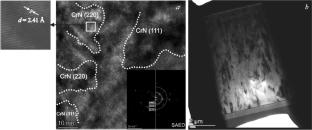Powder metallurgy (PM) Fe (steel) products still suffer from abrasion and fatigue, thus reducing their life expectancy. The physical vapor deposition (PVD) technique can significantly enhance surface wear and fatigue resistance. On the other hand, ultrasonic shot peening (USSP) treatment is an emerging and effective technique that can enhance surface strength and improve surface density, particularly for PM products. Duplexed PM Fe (steel) samples are expected to have excellent mechanical properties and long service life. In this work, PM Fe (steel)-based samples (ρ = 6.9) were prepared as substrates for CrN coatings with and without USSP treatment. Holes sized about 35 μm can be observed on CrN coatings deposited on as-sintered substrates, while the CrN coatings on USSP-treated substrates were very compact. According to the results of scanning electron microscopy (SEM), X-Ray diffraction (XRD), X-ray photoelectron spectroscopy (XPS), and transmission electron microscopy (TEM), the crystal structures and chemical bonds of CrN coatings on different substrates are the same. Nevertheless, CrN coatings were found to be discontinued on sintered substrates because of holes in the surface. In friction tests, such specific structures created plenty of “steps” in the coating, increasing residual stress, which crushed the coatings into fragments and led to severe abrasive wear. Additionally, wear rates would increase with load. Nevertheless, USSP treatment can generate a compact layer, about 700 μm thick, to offer strong support to CrN coatings. Therefore, CrN coatings on the USSP-treated substrates exhibited lower and more stable coefficients of friction and wear rates. This generally describes a simple method to enhance the surface strength and densities of PM Fe (steel) products. Besides, it offers a new way of prolonging the service lives of PM Fe (steel) products by USSP and PVD duplex treatment.



